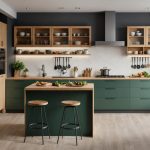Home is where the heart is, and the kitchen often serves as its core. As sustainability becomes more essential, eco-friendly kitchen cabinets are leading the charge toward greener living. This year, innovative designs and sustainable materials are transforming how we think about cabinetry. Explore the latest trends that not only elevate aesthetics but also promote a healthier planet. Discover practical choices that blend functionality with style, proving that eco-conscious can be undeniably chic.
Overview of Eco-Friendly Kitchen Cabinet Trends in 2023
Exploring sustainable choices for modern kitchens.
Also read : Exploring the Hottest Kitchen Island Trends Featuring Integrated Dining Tables
Significance of Eco-Friendly Kitchen Cabinets
In 2023, eco-friendly kitchen cabinets have become a cornerstone of sustainable home design. With the growing awareness of environmental issues, homeowners are increasingly seeking ways to reduce their carbon footprint. This shift has placed a spotlight on sustainability trends in kitchen design, emphasizing the importance of using materials that are both environmentally responsible and durable.
Current Trends in Sustainability
Sustainability in kitchen design is not just a trend but a necessity. The use of recycled materials and low-VOC finishes is on the rise, ensuring that kitchens are not only beautiful but also safe for the environment. Designers are incorporating bamboo and reclaimed wood, which are both renewable resources, into their projects. These materials offer a unique aesthetic appeal while supporting eco-friendly practices.
Topic to read : Crafting a Versatile Kitchen: Perfecting Spaces for Meat Lovers and Plant-Based Chefs Alike
Importance of Material Choice
Choosing the right materials is crucial in creating eco-friendly kitchen cabinets. Opting for sustainably sourced wood and non-toxic adhesives can significantly reduce the environmental impact. Embracing these practices not only benefits the planet but also enhances the overall health of the home environment.
- Bamboo: Fast-growing and renewable
- Reclaimed Wood: Reduces waste and adds character
- Low-VOC Finishes: Improves indoor air quality
These trends illustrate the growing commitment to sustainability in kitchen design, reflecting a broader movement towards environmentally conscious living.
Innovative Materials Used in Eco-Friendly Kitchen Cabinets
Exploring the cutting-edge materials shaping sustainable kitchens today.
Recycled and Reclaimed Materials
The use of recycled wood is gaining traction in the realm of eco-friendly kitchen cabinets. This practice not only conserves natural resources but also reduces waste, offering a sustainable solution for modern kitchens. Reclaimed wood, sourced from old structures, provides a unique character and history to each piece, making it a popular choice for those seeking a distinctive look.
Benefits of Low-VOC and Non-Toxic Finishes
Incorporating low-VOC finishes is crucial for maintaining a healthy home environment. These finishes emit fewer volatile organic compounds, improving indoor air quality and reducing health risks. Non-toxic adhesives further enhance the sustainability of kitchen cabinets, ensuring that they are safe for both the environment and the inhabitants.
Rapidly Renewable Materials
Bamboo stands out as a rapidly renewable material, growing much faster than traditional hardwoods. Its durability and aesthetic appeal make it an ideal choice for eco-conscious homeowners. Other rapidly renewable materials, such as cork and wheatboard, are also being utilized, offering diverse options for sustainable design.
- Recycled Wood: Reduces environmental impact
- Low-VOC Finishes: Enhances air quality
- Bamboo: Combines sustainability with style
Design Inspirations for Eco-Conscious Kitchens
Exploring the aesthetic possibilities in sustainable kitchen design.
Minimalist Design Principles
Incorporating minimalist design principles in eco-friendly kitchens emphasizes simplicity and functionality. This approach reduces clutter and focuses on essential elements, aligning with the ethos of sustainability. Modern eco-friendly aesthetics often feature sleek lines and open spaces, creating a calming environment that promotes mindful living.
Color Palettes and Finishes
Choosing the right color palettes and finishes is crucial in creating a sustainable kitchen. Earthy tones and natural textures are popular, reflecting the connection to nature. These choices not only enhance visual appeal but also support the use of sustainable materials. For instance, matte finishes and natural wood grains can be both stylish and environmentally friendly.
Case Studies of Successful Remodels
Several successful remodels showcase the potential of eco-conscious kitchen design. For example, a recent project in Portland utilized reclaimed wood and low-VOC paints, resulting in a space that is both beautiful and sustainable. These case studies highlight how modern eco-friendly aesthetics can be achieved without compromising on style or functionality.
- Minimalist Design: Emphasizes simplicity
- Color Palettes: Earthy tones and textures
- Successful Remodels: Showcase sustainability in action
By embracing these principles, homeowners can create kitchens that are both aesthetically pleasing and environmentally responsible.
Leading Manufacturers of Eco-Friendly Kitchen Cabinets
Exploring the brands that lead in sustainable cabinetry.
Overview of Top Manufacturers
In the realm of eco-friendly cabinet manufacturers, several brands stand out for their commitment to sustainability. These sustainable brands prioritize environmentally responsible practices, ensuring their products meet high ecological standards. Notable names include IKEA, renowned for its innovative use of recycled materials, and KraftMaid, which emphasizes the use of low-VOC finishes and sustainably sourced wood.
Importance of Green Certifications
Green certifications play a crucial role in identifying sustainable brands. Certifications like FSC (Forest Stewardship Council) and LEED (Leadership in Energy and Environmental Design) assure consumers of the environmental integrity of the products. These certifications are vital for eco-friendly cabinet manufacturers, as they validate their sustainability claims and build consumer trust.
Comparative Analysis of Brands
A comparative analysis of eco-friendly cabinet manufacturers reveals varying degrees of commitment to sustainable practices. For instance, IKEA excels in affordability and accessibility, while KraftMaid focuses on high-quality craftsmanship.
- IKEA: Affordable, accessible, FSC-certified
- KraftMaid: High-quality, LEED-certified
- FSC & LEED: Essential for credibility
By understanding these differences, consumers can make informed decisions when selecting sustainable brands for their kitchen projects.
Tips for Eco-Conscious Remodeling
Exploring sustainable renovation strategies for your kitchen upgrade.
Step-by-Step Guide to Eco-Friendly Remodeling
Embarking on an eco-conscious kitchen remodel involves careful planning. Start by assessing your current kitchen layout and identifying areas for improvement. Prioritize sustainable renovation by selecting materials and practices that minimize environmental impact. Opt for eco-friendly materials like bamboo or recycled wood for cabinets and countertops.
Budget Considerations for Sustainable Materials
Budgeting is crucial in any renovation project. Allocate funds for sustainable materials and energy-efficient appliances. They might have a higher upfront cost, but the long-term savings and environmental benefits are substantial. Consider a phased approach, tackling one section of the kitchen at a time to manage expenses effectively.
- Bamboo Cabinets: Renewable and durable
- Recycled Wood: Eco-friendly and stylish
- Energy-Efficient Appliances: Reduces energy consumption
Integration of Energy-Efficient Appliances
Incorporating energy-efficient appliances is a key aspect of an eco-friendly remodeling. Choose appliances with high Energy Star ratings to ensure minimal energy use. Additionally, consider installing LED lighting and water-saving fixtures to further enhance sustainability.
By following these steps, you can achieve a kitchen upgrade that aligns with your eco-conscious values while enhancing functionality and style.
Resources and References for Sustainable Kitchen Design
Exploring the wealth of knowledge in sustainable kitchen design.
Authoritative Sources on Sustainability
For those seeking to delve deeper into sustainable design resources, several authoritative sources offer invaluable insights. The U.S. Green Building Council provides comprehensive guidelines on eco-friendly building practices, emphasizing the importance of industry standards. Additionally, the Environmental Protection Agency (EPA) offers resources focused on sustainable materials and practices.
Industry Standards and Best Practices
Industry standards play a pivotal role in guiding sustainable kitchen design. The Leadership in Energy and Environmental Design (LEED) certification sets benchmarks for energy efficiency and environmental responsibility. Adhering to these standards ensures that kitchen designs are both functional and eco-friendly.
- LEED Certification: Ensures energy efficiency
- EPA Guidelines: Focus on sustainable materials
- USGBC: Offers eco-friendly building practices
Recommendations for Further Research
For further exploration, consider consulting expert recommendations in sustainable kitchen design. Books such as "The Sustainable Kitchen" provide detailed strategies and expert recommendations for creating an eco-friendly space. Engaging in webinars and workshops hosted by sustainable design resources can also enhance understanding and application of best practices.
By leveraging these resources, homeowners and designers can make informed decisions that align with industry standards and expert recommendations.













